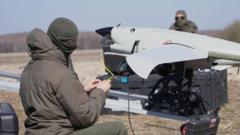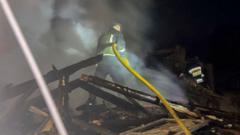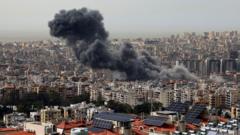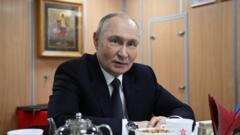At a covert facility, Ukrainian developers are putting the advanced Raybird drone to test, amidst concerns that newly established energy ceasefire agreements with Russia will falter under pressure.
Ukrainian Drone Makers Anticipate Challenges Amidst Energy Ceasefire Agreements

Ukrainian Drone Makers Anticipate Challenges Amidst Energy Ceasefire Agreements
The development of long-range drones continues as Ukrainian engineers doubt the sustainability of recent ceasefire agreements made with Russia.
Article text:
In a hidden location far from public scrutiny, Ukrainian engineers are rigorously testing a long-range drone named Raybird. This advanced machine, which resembles a mini airplane, is expertly poised on a launchpad, prepared for deployment akin to an arrow being released from a crossbow. The Raybird boasts an impressive endurance, flying for over 20 hours and covering distances greater than 1,000 kilometers (620 miles), conducting missions aimed at crucial targets, including oil refineries and fuel depots located both on the frontlines and deep within Russian territory.
With the recent conclusion of separate ceasefire agreements between Russia and Ukraine—partly facilitated by the United States—operational missions of such nature are expected to cease. These agreements include a maritime ceasefire in the Black Sea, with both nations pledging to refrain from attacking each other's energy assets—an undertaking previously agreed upon but not fully adhered to. President Volodymyr Zelensky expressed Ukraine's intention to follow through with these arrangements immediately.
However, skepticism looms among Ukrainian engineers, particularly Oleksiy from the Skyeton company, which develops the Raybird. He articulated concerns over Russia's credibility regarding adherence to the ceasefire, referencing historical patterns where agreements end up benefiting Moscow while potentially binding Ukraine's ability to retaliate. "[Russians punch you in the face, then the next day they make an agreement but ask to tie up your hands. So the possibility that they will continue fighting remains," says Oleksiy.
The ceasefire agreement may also imply significant relief for Russia, which has endured over 30 Ukrainian attacks on its oil infrastructure this year alone, leading to an estimated 10% drop in its refining capacity. Russia's recent extension of a ban on petroleum exports suggests the impact of these drone assaults is being felt—seriously undermining its energy resources.
On the Ukrainian front, President Zelensky disclosed advancements in drone technology, revealing that engineers have achieved designs for drones capable of striking targets as far as 3,000 km (1,860 miles) away, extending their reach into Russian territory, including major cities like Moscow and as far as Siberia. Additionally, turbojet-powered missile-drones that offer high speed and lower interceptability are also under development, alongside upgraded cruise missiles able to target naval installations with precision.
These advancements come at a critical time, as Russia has made attempts to bombard Ukraine’s energy infrastructure, a strategy aimed at crippling the nation's energy independence. Last winter, Ukraine's energy generation capacity plummeted to just one-third of its normal levels due to relentless strikes on power stations and gas facilities.
Despite potential benefits arising from the energy ceasefire for Ukraine, including a temporary halt against attacks on energy facilities, concerns linger that Moscow may not respect the peace initiative. Oleksiy reiterated the importance of ongoing development in weaponry, affirming that even with a ceasefire in place, the urgency for innovation and preparedness remains paramount. "Our enemy just wants to have a break, gather its strength and attack again," he warns. "We must be ready for that."
In a hidden location far from public scrutiny, Ukrainian engineers are rigorously testing a long-range drone named Raybird. This advanced machine, which resembles a mini airplane, is expertly poised on a launchpad, prepared for deployment akin to an arrow being released from a crossbow. The Raybird boasts an impressive endurance, flying for over 20 hours and covering distances greater than 1,000 kilometers (620 miles), conducting missions aimed at crucial targets, including oil refineries and fuel depots located both on the frontlines and deep within Russian territory.
With the recent conclusion of separate ceasefire agreements between Russia and Ukraine—partly facilitated by the United States—operational missions of such nature are expected to cease. These agreements include a maritime ceasefire in the Black Sea, with both nations pledging to refrain from attacking each other's energy assets—an undertaking previously agreed upon but not fully adhered to. President Volodymyr Zelensky expressed Ukraine's intention to follow through with these arrangements immediately.
However, skepticism looms among Ukrainian engineers, particularly Oleksiy from the Skyeton company, which develops the Raybird. He articulated concerns over Russia's credibility regarding adherence to the ceasefire, referencing historical patterns where agreements end up benefiting Moscow while potentially binding Ukraine's ability to retaliate. "[Russians punch you in the face, then the next day they make an agreement but ask to tie up your hands. So the possibility that they will continue fighting remains," says Oleksiy.
The ceasefire agreement may also imply significant relief for Russia, which has endured over 30 Ukrainian attacks on its oil infrastructure this year alone, leading to an estimated 10% drop in its refining capacity. Russia's recent extension of a ban on petroleum exports suggests the impact of these drone assaults is being felt—seriously undermining its energy resources.
On the Ukrainian front, President Zelensky disclosed advancements in drone technology, revealing that engineers have achieved designs for drones capable of striking targets as far as 3,000 km (1,860 miles) away, extending their reach into Russian territory, including major cities like Moscow and as far as Siberia. Additionally, turbojet-powered missile-drones that offer high speed and lower interceptability are also under development, alongside upgraded cruise missiles able to target naval installations with precision.
These advancements come at a critical time, as Russia has made attempts to bombard Ukraine’s energy infrastructure, a strategy aimed at crippling the nation's energy independence. Last winter, Ukraine's energy generation capacity plummeted to just one-third of its normal levels due to relentless strikes on power stations and gas facilities.
Despite potential benefits arising from the energy ceasefire for Ukraine, including a temporary halt against attacks on energy facilities, concerns linger that Moscow may not respect the peace initiative. Oleksiy reiterated the importance of ongoing development in weaponry, affirming that even with a ceasefire in place, the urgency for innovation and preparedness remains paramount. "Our enemy just wants to have a break, gather its strength and attack again," he warns. "We must be ready for that."



















